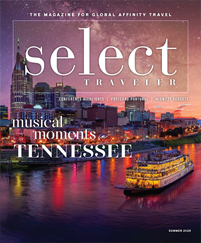South Carolina’s coastal area boasts some of the most popular vacation destinations on the Eastern Seaboard, but there’s more to the Palmetto State than the ocean and the low country. In the northwestern part of the state, the mountainous landscape makes for great outdoor activity and hides a few surprising group experiences. And Columbia, the capital city in the center of the state, is a hub of cultural activity.
Mountains: Blue Ridge and BMWs
In the northwest corner of South Carolina, Greenville combines its mountainous surroundings with a hip urban environment and progressive outlook.
Visitors can get their fill of mountain beauty at the Blue Ridge Escarpment, the area where the Blue Ridge Mountains descend toward the Piedmont of eastern South Carolina. The escarpment is home to more than 300 species of wildlife and 50 waterfalls. The best place to visit the escarpment near Greenville is Table Rock Mountain, part of the 11,000-acre Mountain Bridge Wilderness Area.
The Reedy River runs through Greenville’s Historic West End, and in 2004, the city built the beautiful Falls Park around the stretch of the river in the urban area. The park serves as an oasis in the city and is used for public art displays and as a jumping-off point for river exploration.
It’s no surprise that there’s lots of outdoor activity to enjoy in Spartanburg, a town about 30 miles east of Greenville. But what may be surprising is that it is also home to the Performance Center, a one-of-a-kind BMW plant that manufactures more than 300,000 cars a year. Groups can tour the adjacent BMW museum called Zentrum.
Central: Cultural Columbia
About halfway between the mountains and the coast in central South Carolina, Columbia serves as the state’s capital in a variety of respects. In addition to being the seat of government, Columbia is home to the University of South Carolina and is a cultural hub for the state.
One of the best ways for groups to discover Columbia’s intellectual and political power is by visiting the South Carolina State Museum, the largest museum in the state. This 210,000-square-foot institution features four floors of exhibits, a digital dome planetarium, a 4-D interactive theater and an observatory.
Exhibits at the museum cover four areas: art, history, natural science and technology. Among the highlights are a life-size reproduction of the Confederate submarine the Hunley and the Clemson 372, the first airplane in the United States built by college students. Its Cotton Mill Exchange is the largest museum store in the Southeast.
The Riverbanks Zoo and Gardens is a 170-acre site with more than 2,000 animals, as well as botanical gardens. The zoo features scenic river vistas, natural animal habitats and views of significant Columbia historical landmarks.
Coast: History and Entertainment
Low country cuisine, historic architecture, hundreds of miles of coastline and dozens of energetic entertainment options come together to make the cities of the South Carolina coast some of the most popular travel destinations on the Atlantic Ocean.
With expansive stretches of beaches and a booming amusement and entertainment scene, Myrtle Beach has long been a favorite destination for Southerners seeking sand, surf and sunshine. An array of attractions and activities beyond the beach will keep visitors of various interests occupied.
Tour groups may or may not spend time on the beach, but every group that visits the Myrtle Beach area spends some time taking advantage of the area’s rich entertainment scene. Numerous venues, including the Carolina Opry and Legends in Concert, offer musical revue shows, with both afternoon and evening performances available.
There are also immersive and themed comedy shows. Medieval Times features a full meal and medieval equestrian tournament, and Pirates Voyage includes dinner and an inventive aquatic show.
About 100 miles down the coast, Charleston is about as different from Myrtle Beach as could be. This historic city oozes Southern charm and has stories to tell that range from its Colonial founding through the Civil War and into the modern era. The city has also become known as a hot spot for new Southern art and cuisine.
No matter what side of Charleston you want to explore, there is a walking tour designed to showcase it. Numerous companies offer guided tours through the historic district that last for about two hours and give participants an overview of the city’s history, culture, antebellum homes, architecture and gardens. Ghost tours and pirate tours offer popular variations on the historical theme.
Beyond history, niche walking tour companies cater to special interests. Groups can choose from photography tours, food tours, immersive historical tours and even outings that include high tea in a private home.









